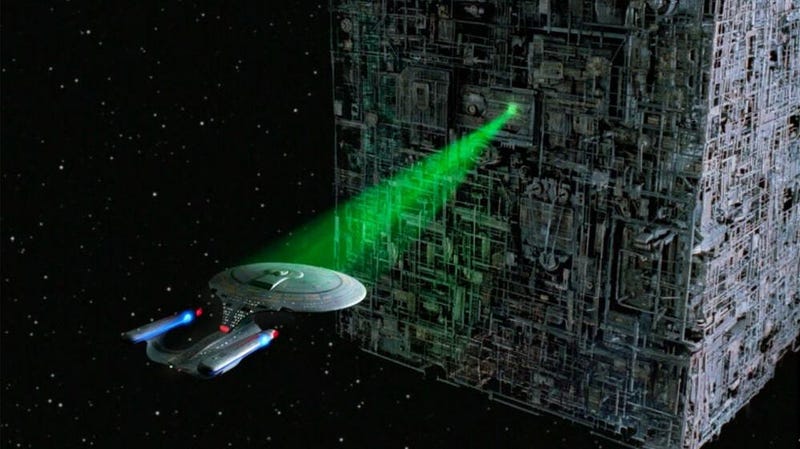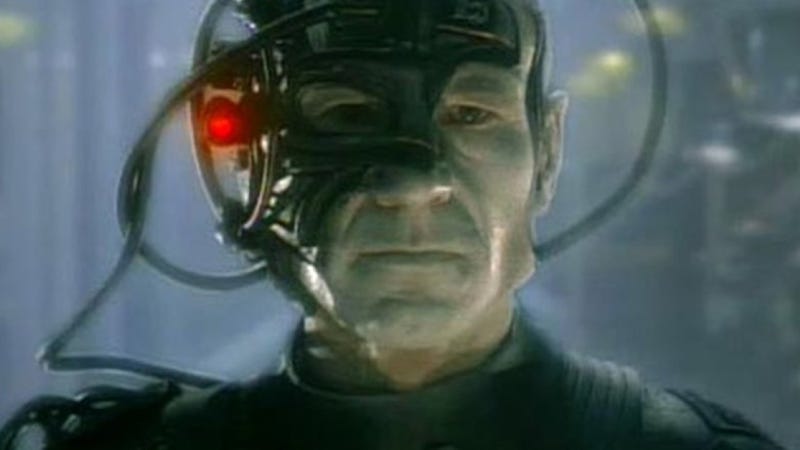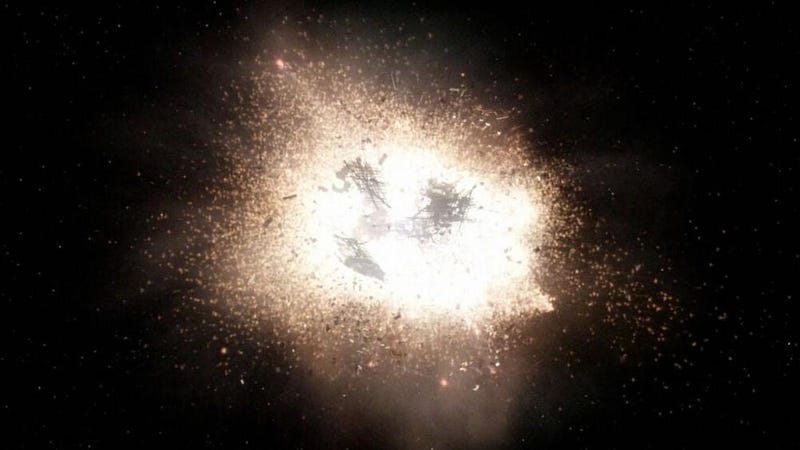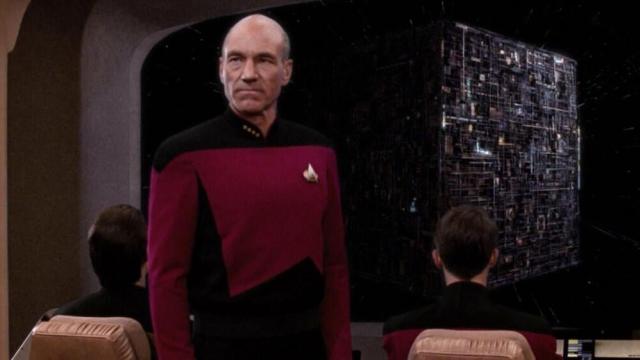Star Trek’s idyllic utopia might try to move past it, but it is defined by conflict. From the long moral question of whether or not Starfleet is a military or scientific organization at its core, to the deadly wars that have pushed it to defend its greatest ideals, Star Trek as we know it cannot exist without battle—and the sting of defeat. Which is why one of its most iconic moments isn’t a stirring speech or wanderlust-driven exploration, but a terrible, terrible loss.
First depicted in the legendary Next Generation two-parter “The Best of Both Worlds,” the Battle of Wolf 359 is actually barely seen on screen in the episode. And yet, its infamy, its context, has persisted for generations—shaping not just the legacy of The Next Generation and successor series like Picard, but DS9, and the very heart of Starfleet itself. There may have been greater battles, longer wars, more shocking acts of death and destruction—but it’s hard to imagine what Star Trek could ever do to top the reach and importance of Wolf 359.
The Prelude

It had been over a year, and a season-and-a-half of television, since TNG viewers had been introduced to the mysterious, ominous threat of the Borg. Whisked beyond the outskirts of the furthest reaches of Federation Space in the season two episode “Q Who,” the Enterprise bore witness to the unknown that could undo not just itself, but all of the Federation. So when season three of the show climaxed in “The Best of Both Worlds,” opening on a missing colony with devastation eerily similar to what was seen back in “Q Who,” the tone is immediately set—and it’s a tension that builds and builds in its first half unlike anything the show had done up to that point.
There’s moments here and there, like the realiwation from Admiral Hanson and Commander Shelby that Starfleet has to prepare for a potential invasion force, or the destruction of the USS Lalo in the dead of night, as the Borg got closer and closer. The stage is set for a one-on-one encounter between the Enterprise and the Borg cube, but both our heroes and the audience know how that battle will go. Except it doesn’t, with a twist on a twist—the Enterprise’s tussle with the cube is brief, immediately swept up in a race against time and a hostage situation when the Borg capture Captain Picard and begin dashing for Sector 001: Earth, the heart of the Federation itself.
Although the Enterprise managed to shunt the cube out of warp, doing so led to a horrific discovery: the Borg hadn’t just abducted Picard, but assimilated him, transforming him into the command drone Locutus. The best of Starfleet’s tactical acumen, merged with the technological might of the Collective, the perversion of one of its greatest leaders, all as horrific as the Enterprise being left battered and bruised in Locutus’ wake. And so the stage was set: The Next Generation’s stars were out of the fight, and 40 ships, unlike anything marshalled on screen in Star Trek before, were made ready to face off against the shadow of a fallen hero.
The Battle

The Next Generation never actually depicts the Battle of Wolf 359 on screen, as we follow the battered Enterprise as it tries to give chase after emergency repairs. The most of it we ever see on television comes years after in Deep Space Nine’s premiere episode, “Emissary,” and much later still in flashes of Star Trek: Picard. What we do know from those moments is that the battle between Starfleet and the Borg is over in a matter of minutes.
Uncertain of how to tactically approach the Borg, while the Borg and themselves had assimilated all of Picard’s experience and strategic information, the Battle of Wolf 359 was arguably over before the first phasers were fired: line after line of Starfleet ships charged the Borg cube, and at Locutus’ command, the Borg cut them down in a barrage of strategically timed tractor beams and lancing phaser volleys.
The Loss

By the time the Enterprise-D arrived at Wolf 359, they knew the battle had taken a turn—communications between the newly field-promoted Captain Riker and Admiral Hanson had been cut off mid-way, as the admiral attempted to rally what was left of the fleet as the tide went against Starfleet. Upon arriving in the Wolf system, the Enterprise finds no life readings when there should be thousands upon thousands: and only the debris of dozens and dozens of starships.
The Aftermath

Of the 40 Starfleet ships that engaged at Wolf 359, just a single vessel survived—and decades later, we still don’t really know which one. It’s never been explicitly confirmed, but offhand mentions in Voyager and an eventual re-appearance in Star Trek: First Contact suggest the USS Endeavour, helmed by Captain Amasov, as a likely candidate. At least one Federation civilian vessel was also destroyed in the crossfire. In all, 11,000 people—Starfleet officers and civilian families onboard the engaging vessels—were either killed or assimilated by the Borg.
As the cube drew closer and closer to Earth—breaching defence platforms positioned at Mars and entering orbit above the planet—the conflict resulted in a Pyrrhic victory for Starfleet when the repaired Enterprise, having recaptured Locutus, used the drone’s collective link to issue a kill-switch command to the Borg, destroying the cube. Picard would eventually be restored to his human self after his link to the collective was severed and he underwent reconstructive surgery to remove the implants given to him by the Borg, but while the threat of the Borg was momentarily halted, Wolf 359’s devastation echoed throughout the Federation; at that point—just years before the outbreak of the Dominion War—it was the deadliest single engagement in Starfleet history.
The Legacy

The Battle of Wolf 359’s legacy goes much further than just “The Best of Both Worlds,” both in and out of the text of Star Trek itself. The trauma of the incident follows Picard throughout the remainder of TNG, brought up explicitly in episodes like the following season’s “Family” and “The Drumhead,” and of course in Star Trek: First Contact and its renewed engagement with the Borg in Sector 001, set just six years after the events of “The Best of Both Worlds.”
It touches other important Star Trek figures beyond Picard, too. The vast majority of what we’ve actually seen of Wolf 359 is almost entirely from the perspective of Deep Space Nine’s Captain Sisko during the show’s premiere, where we see the destruction of the ship he served on, the USS Saratoga, as well as the death of his wife—something he ultimately places directly on Picard when the two briefly butt heads later on in the episode. Later still in Picard’s third season, we learn that the USS Titan’s Captain Shaw served as an engineer aboard the Constance during the battle, and was just one of 10 survivors randomly selected to use the ship’s remaining functioning escape pod. The exploration of Picard’s trauma, and then eventually Sisko’s, sets the stage for what Deep Space Nine would go on to do in its storylines with the Dominion War in its latter half.
The battle is also another important moment in that age-old existential Star Trek metacommentary: is Starfleet a research organisation with an exploratory and diplomatic mission, or is it a military force? What does it mean for its aims and intents in its depiction of a post-scarcity utopia that it has to be both at once? Wolf 359 sees Starfleet’s ideals—that its ships, while armed for defence, were primarily vessels of science and exploration, places that housed not just Starfleet personnel but their families, had libraries and schools and recreational areas as necessary as tactical and scientific ones—laid low in the worst possible way. The battle is directly responsible for Starfleet’s first explicitly designed warship, the Defiant-class that became the vessel of Deep Space Nine’s crew, something that had at that point in the franchise been almost alien and inconceivable to imagine.
Star Trek would go on to depict bigger and more explosive battles, and place war throughout its history, from the conflict with the Dominion to Discovery’s exploration of the war with the Klingons a century prior. But few moments could ever match the gut-wrenching tragedy of Wolf 359, in spite of dwarfing its scope—a battle barely seen, but one whose scars are forever etched across generations of Star Trek.
